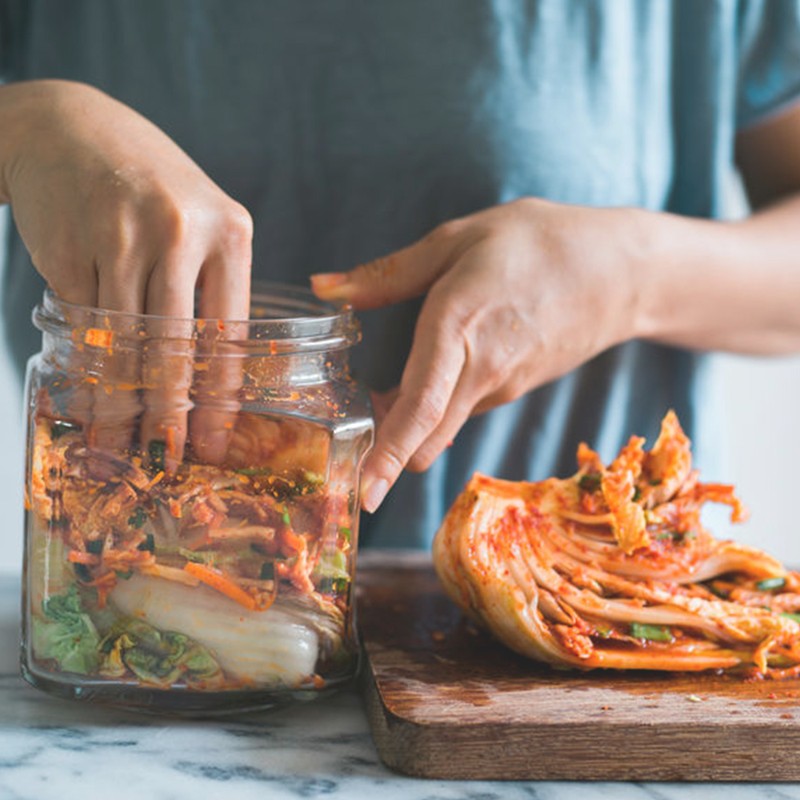Kimchi: Health Benefits & Recipe Ideas
What is kimchi?
Let’s just say, you haven’t lived until you’ve tried kimchi. A staple in Korean cuisine, the fermented vegetable mix is usually served as a side dish and contains napa cabbage, along with a whole host of spices, including chilli powder, spring onions, garlic and ginger. But there are hundreds of varieties of kimchi available – some people make it with cucumber, daikon radishes, bok choy, pumpkins, beansprouts – basically, any vegetable you want to throw in there, works.
Is it good for you?
You can’t have that amount of vegetables in one dish and it not be. Fermented foods like kimchi are essentially probiotics, which means they’re particularly good for gut health, digestive issues and inflammation, and can help boost naturally beneficial bacteria: “Healthy gut flora plays a role in boosting your defence against infectious bacteria and reducing the bloat,” says Henrietta Norton, Harley Street Nutritionist and founder of Wild Nutrition, “and meals that include fermented foods like kimchi will feed the growth of good bugs in your digestive system.” Beyond this, kimchi is known for being an excellent source of vitamins K, C and B6, as well as being high in fibre, calcium, iron and potassium. And the best bit is, kimchi is vegan, so can be enjoyed by everyone.
How exactly do you make it?
As previously mentioned, there is a whole host of ways to make kimchi. Nutritionist and personal trainer Sophie Thurner makes her own kimchi by mixing together Chinese leaf cabbage, daikon radish, carrot and spring onion. You also need a sauce made up of blended chilli, garlic, soy sauce (or tamari for gluten-free) and fish sauce or miso paste for a vegan alternative. I also like to add sesame seeds," she explains. "To prepare the kimchi you first need to add lots of salt to the cabbage so that it becomes soft and the moisture is drawn out. Once this is done, rinse, drain and pat dry the cabbage and add all the ingredients in a mixing bowl, give it a good mix, transfer to a jar and let it stand at room temperature out of direct sunlight to start the fermentation process. How long to ferment is up to you. It typically takes 36 hours, but the longer you ferment the kimchi, the tangier and intense the flavour will be, and the more tender the cabbage will become."
Jamie Oliver’s simple recipe for basic kimchi is spiced up with garlic, ginger, shrimp paste, Daikon radishes and spring onions. On the other hand, food and travel blog Whip & Wander discovered a Hawaiian Spicy Kimchi Ahi Poke recipe whilst on holiday in Kauai, which mixes the usual veggies with ahi tuna and sriracha sauce. Meanwhile, cook Nigel Slater loves the sweet and sour taste, preparing a red cabbage kimchi that packs a punch – not enough to produce “actual teary-type heat, but at least enough to make your eyes sparkle” – with gochujang chilli paste.
Once you’ve made it, how do you serve it?
Tommy Heaney, Chef Proprietor of Heaneys in Cardiff loves its versatility. “It goes with almost everything – although dessert could be a test!” He tells us. We cook with kimchi in various forms serving it with Iberico pork and miso, and then using the juice to form a jus which we then serve with spider crab. We’re also planning on using it at our new coffee and wine bar Uisce – we’re planning on pairing it with a confit Goosnargh duck crumpet.” For something a little easier for us amateur chefs to cook, Sophie likes to add it to lentil stews, in a sandwhich with strong cheese or as a side to a steak, while vegan food writer Meera Sodha enjoys her kimchi in a vegan pancake: “When I when I [discovered kimchi], there were fireworks. A jeon is a forgiving pancake that absorbs tofu and most vegetables, but still becomes crisp, given enough time in the pan.”
If you’re not much of a cook, here are the best ready-made varieties to choose from:
The Cultured Collective: This authentic traditional-style Kimchi uses a mixture of Chinese leaf cabbage, daikon radish, carrot and spring onion together with a secret spice blend to bring you a Kimchi that is piquant, with moreish umami notes and a satisfying crunch.
Abel & Cole: This cabbage-based kimchi is preserved with punchy spices and herbs to lock in the unique, tangy flavour, and has an added kick of golden turmeric and black pepper for a full-flavoured, fragrant finish.
Yumchi: An interesting take on the original, Yumchi’s kimchi contains apples and pears alongside the usual cabbage and carrots.
Eaten Alive: If you’re not a huge fan of spice, then Eaten Alive’s version of kimchi will be right up your street – this raw, hand-cut version is made milder for sensitive tastebuds.
Kimchi Recipes
Want to try making a meal using this flavoursome condiment? From Korean spiced beef bowls to kimchi salad, here are some easy dishes that will really pack a punch...
DISCLAIMER: We endeavour to always credit the correct original source of every image we use. If you think a credit may be incorrect, please contact us at info@sheerluxe.com.

/https%3A%2F%2Fsheerluxe.com%2Fsites%2Fsheerluxe%2Ffiles%2Farticles%2F2019%2F04%2Fcurrymisoramen.jpg?itok=PNlhYe8C)
/https%3A%2F%2Fsheerluxe.com%2Fsites%2Fsheerluxe%2Ffiles%2Farticles%2F2019%2F04%2Fkorean-style-beef-bowls-zucchini-noodlespg101.jpg?itok=eewEbHNf)
/https%3A%2F%2Fsheerluxe.com%2Fsites%2Fsheerluxe%2Ffiles%2Farticles%2F2019%2F04%2Flatenightmisoramen.jpg?itok=rVFWIk8K)
/https%3A%2F%2Fsheerluxe.com%2Fsites%2Fsheerluxe%2Ffiles%2Farticles%2F2019%2F04%2Fpearl-barley-sald.jpg?itok=1MRdlHr2)

